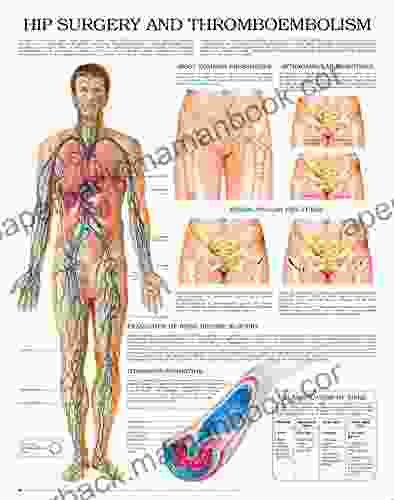Hip Surgery and Thromboembolism: Comprehensive Guide with Charts and Illustrations

Hip surgery is a common orthopedic procedure performed to alleviate pain and improve function in the hip joint. However, like any surgical intervention, it carries certain risks, including the development of thromboembolism.
Thromboembolism is a condition in which a blood clot (thrombus) forms in a blood vessel and travels through the bloodstream, potentially blocking other vessels and causing serious complications. In the context of hip surgery, thromboembolism can manifest as deep vein thrombosis (DVT) or pulmonary embolism (PE).
The risk of developing thromboembolism following hip surgery is influenced by various factors, including:
5 out of 5
| Language | : | English |
| File size | : | 4886 KB |
| Text-to-Speech | : | Enabled |
| Screen Reader | : | Supported |
| Enhanced typesetting | : | Enabled |
| Print length | : | 13 pages |
| Lending | : | Enabled |
Patient-Related Factors:
- Age (over 40 years)
- Obesity
- History of blood clots
- Family history of blood clots
- Cancer
- Smoking
- Hormone replacement therapy
Surgery-Related Factors:
- Type of hip surgery (e.g., total hip replacement, hip resurfacing)
- Surgical approach (e.g., anterior, posterior)
- Surgical duration
Other Factors:
- Immobilization
- Dehydration
- Pregnancy
Deep Vein Thrombosis (DVT):
- Swelling in the affected leg
- Pain or tenderness in the lower leg or thigh
- Discoloration or redness of the skin
- Warmth to the touch
Pulmonary Embolism (PE):
- Sudden shortness of breath
- Chest pain
- Coughing up blood
- Rapid heart rate
- Lightheadedness or fainting
To minimize the risk of thromboembolism following hip surgery, a multifactorial approach is adopted, which includes:
- Mechanical Prophylaxis: Using devices such as compression stockings or intermittent pneumatic compression devices to promote blood flow in the legs.
- Pharmacological Prophylaxis: Administering blood-thinning medications to prevent clot formation.
- Early Mobilization: Encouraging the patient to move and walk as soon as possible after surgery.
- Hydration: Ensuring adequate fluid intake to prevent dehydration.
If a patient experiences symptoms suggestive of thromboembolism, a thorough evaluation is performed to confirm the diagnosis. This may involve:
- Physical Exam: Assessing for swelling, tenderness, and other clinical signs.
- Ultrasound: Using sound waves to visualize the blood vessels and identify blood clots.
- Blood Tests: Checking for elevated levels of D-dimer, a protein fragment released during clot breakdown.
- Chest X-ray or CT Scan: To detect a possible pulmonary embolism.
The treatment for thromboembolism depends on the location and severity of the clot. Options include:
- Anticoagulant Medications: These medications are used to prevent further clot formation and dissolve existing clots.
- Clot Removal Surgery: In some cases, surgery may be necessary to remove a large clot from a major blood vessel.
- Thrombolytic Therapy: This involves administering drugs to dissolve blood clots.
Following treatment for thromboembolism, the patient will undergo a period of rehabilitation to restore function and prevent recurrence. This may include:
- Gradual increase in activity levels
- Physical therapy to improve mobility and strength
- Continued use of anticoagulant medications as prescribed
Chart 1: Risk Factors for Thromboembolism after Hip Surgery
| Risk Factor | Description | |---|---| | Age > 40 years | Increased risk with each passing decade | | Obesity | Body mass index (BMI) ≥ 30 kg/m² | | History of blood clots | Previous experience with DVT or PE | | Family history of blood clots | First-degree relative with a history of clots | | Cancer | Especially those involving the abdomen or pelvis | | Smoking | Nicotine increases platelet aggregation and clot risk | | Hormone replacement therapy | Estrogen-based treatments may increase clotting risk |
Illustration 1: Locations of Deep Vein Thrombosis (DVT)
[Image of a human leg with arrows indicating common sites of DVT: calf veins, thigh veins, and pelvic veins]
Illustration 2: Symptoms of Pulmonary Embolism (PE)
[Image of a person clutching their chest with a diagram overlay showing the pathway of a blood clot traveling to the lungs]
Chart 2: Management of Thromboembolism after Hip Surgery
| Treatment | Description | |---|---| | Mechanical Prophylaxis | Compression stockings, intermittent pneumatic compression devices | | Pharmacological Prophylaxis | Blood-thinning medications (e.g., heparin, warfarin) | | Early Mobilization | Walking and other activities as soon as possible after surgery | | Hydration | Intravenous fluids or oral rehydration |
Hip surgery is a valuable treatment option for patients experiencing hip pain and dysfunction. However, it is crucial to be aware of the potential risk of thromboembolism and to take appropriate measures to prevent and manage this complication. By implementing evidence-based protocols and educating patients about risk factors and symptoms, orthopedic surgeons and healthcare professionals can minimize the occurrence of thromboembolism and optimize patient outcomes.
5 out of 5
| Language | : | English |
| File size | : | 4886 KB |
| Text-to-Speech | : | Enabled |
| Screen Reader | : | Supported |
| Enhanced typesetting | : | Enabled |
| Print length | : | 13 pages |
| Lending | : | Enabled |
Do you want to contribute by writing guest posts on this blog?
Please contact us and send us a resume of previous articles that you have written.
 Top Book
Top Book Novel
Novel Fiction
Fiction Nonfiction
Nonfiction Literature
Literature Paperback
Paperback Hardcover
Hardcover E-book
E-book Audiobook
Audiobook Bestseller
Bestseller Classic
Classic Mystery
Mystery Thriller
Thriller Romance
Romance Fantasy
Fantasy Science Fiction
Science Fiction Biography
Biography Memoir
Memoir Autobiography
Autobiography Poetry
Poetry Drama
Drama Historical Fiction
Historical Fiction Self-help
Self-help Young Adult
Young Adult Childrens Books
Childrens Books Graphic Novel
Graphic Novel Anthology
Anthology Series
Series Encyclopedia
Encyclopedia Reference
Reference Guidebook
Guidebook Textbook
Textbook Workbook
Workbook Journal
Journal Diary
Diary Manuscript
Manuscript Folio
Folio Pulp Fiction
Pulp Fiction Short Stories
Short Stories Fairy Tales
Fairy Tales Fables
Fables Mythology
Mythology Philosophy
Philosophy Religion
Religion Spirituality
Spirituality Essays
Essays Critique
Critique Commentary
Commentary Glossary
Glossary Bibliography
Bibliography Index
Index Table of Contents
Table of Contents Preface
Preface Introduction
Introduction Foreword
Foreword Afterword
Afterword Appendices
Appendices Annotations
Annotations Footnotes
Footnotes Epilogue
Epilogue Prologue
Prologue Michael Robins
Michael Robins John Scalzi
John Scalzi Frank Belknap Long
Frank Belknap Long J T Baier
J T Baier Jean Marc Martin
Jean Marc Martin Heather Gudenkauf
Heather Gudenkauf Dewey Lambdin
Dewey Lambdin Nancy Lawson
Nancy Lawson Cyrus Parker
Cyrus Parker Bliss Perry
Bliss Perry Tanya Goodin
Tanya Goodin Matthew Mcconaughey
Matthew Mcconaughey Scotty Scott
Scotty Scott Daniel Patterson
Daniel Patterson Tony Pereda
Tony Pereda Ken Mondschein
Ken Mondschein Judy Folger
Judy Folger Ron Collins
Ron Collins Lillian Day
Lillian Day Jackie Newgent
Jackie Newgent
Light bulbAdvertise smarter! Our strategic ad space ensures maximum exposure. Reserve your spot today!

 Braden WardMy First Piano Adventure Christmas Skips On The Staff: A Review of My First...
Braden WardMy First Piano Adventure Christmas Skips On The Staff: A Review of My First... Brody PowellFollow ·17k
Brody PowellFollow ·17k Marc FosterFollow ·7.3k
Marc FosterFollow ·7.3k J.R.R. TolkienFollow ·6.4k
J.R.R. TolkienFollow ·6.4k Jim CoxFollow ·3.5k
Jim CoxFollow ·3.5k Juan RulfoFollow ·10.5k
Juan RulfoFollow ·10.5k Joseph HellerFollow ·16.5k
Joseph HellerFollow ·16.5k Hayden MitchellFollow ·17.3k
Hayden MitchellFollow ·17.3k Carl WalkerFollow ·6.5k
Carl WalkerFollow ·6.5k

 Jeremy Mitchell
Jeremy MitchellPlay We Now On Christmas Violin Christmas: A Heartfelt...
Play We Now On...

 Terry Bell
Terry BellTales from the Road: Confessions of an Atlanta Uber...
In the vibrant...

 Ervin Bell
Ervin BellThe French Admiral: A Gripping Naval Adventure with Alan...
In the vast expanse of...

 Henry David Thoreau
Henry David ThoreauCrochet Cozy Afghan Patterns: Crochet Weekend Afghan...
to Crochet...

 Orson Scott Card
Orson Scott CardAn Archaeological View Of The Industrialization Of North...
The industrialization of North America was a...

 Josh Carter
Josh CarterClipboard Christmas Skits by Tom Spence: A Festive...
A Christmas...
5 out of 5
| Language | : | English |
| File size | : | 4886 KB |
| Text-to-Speech | : | Enabled |
| Screen Reader | : | Supported |
| Enhanced typesetting | : | Enabled |
| Print length | : | 13 pages |
| Lending | : | Enabled |










